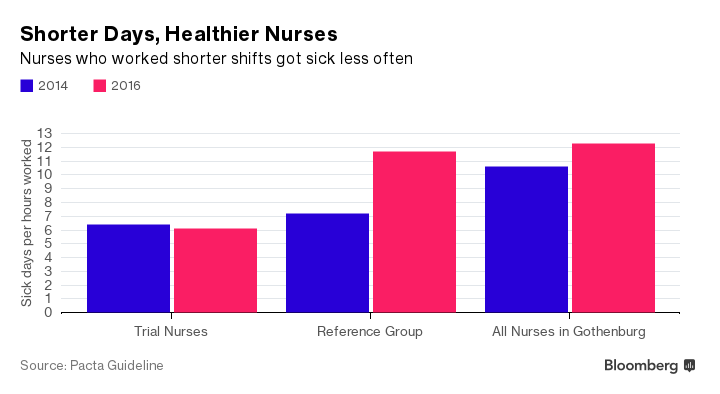working
But a more careful analysis of the results of the Gothenburg experiment shows that the management of the clinic has not taken into account the long-term economic benefits from a six-hour day.
]
The main unaccounted factor in the statistics of the Gothenburg clinic is the improvement of the health of employees (more precisely, the employees-nurses of the clinic) after switching to a six-hour working day. As a result, the number of hospital days that they take, and the amount of health care costs are significantly reduced.
The unused benefits are listed in a scientific paper published by the researcher Bengt Lorentzon.

The analysis showed that nurses on a six-hour day began to take fewer sick leave than when they worked eight hours. Moreover, they took fewer hospitals than all the nurses in all the clinics in Gothenburg. In the transition to the six-hour schedule, the number of hospital patients decreased by 4.7%, and the difference with the control group was 62.7%.
At the same time, nurses began to take slightly less unplanned compensatory time off. This is also quite logical, given that the employees have more free time for personal affairs.
The organizers of the experiment recognized that the improved mood and health of nurses positively affected the quality of care. But they did not consider the long-term economic effect of improving the health of employees.
It should be noted that in general, nurses in Sweden have worse health than women of all other professions. For example, they have a higher body mass index than the average worker.
But a two-year experiment showed that the health of nurses in the Svartedalens clinic, who were transferred to a six-hour day, is better than their colleagues from other clinics. In particular, they have a more satisfactory blood pressure.
It is known from other studies that for health care expenses, healthier employees can be half as low. Studying the health and insurance costs of 10,000 health professionals in Florida’s health system showed that workers with “ideal” cardiovascular health care spend $ 4000 less on medical care than workers in the “poor” state of the cardiovascular system. However, when the insurance costs are taken into account in the United States, it is necessary to remember the exceptionally high prices for medical services in this country. For example, a fracture of the foot with an emergency call and a few days in the hospital will easily cost the patient $ 100,000. Therefore, it is so important to have medical insurance that covers these expenses.
This example shows that the organizers of the experiment in Gothenburg did not take into account all possible The benefits of moving to a six-hour day. In particular, the savings on medical care due to improved health of the employees were not taken into account at all. Perhaps some other factors have also been missed.
Obviously, better efficiency and a better mood of employees should also bring some economic benefit to the employer. In the case of nurses, it is difficult to quantify this benefit, but it is definitely there. For example, in software companies, some employers spend hundreds of thousands of dollars to improve mood and reduce the stress of employees – use massages, give access to the gym and free food. But with the transition to a six-hour day, the mood improves and the level of stress decreases as if by itself, although in the US or Russia, for example, this option is usually not considered at all.
Is it possible to simply avoid this stress instead of actively fighting stress?








